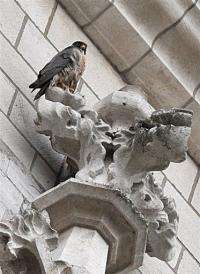Webcam follows Peregrine Falcons

A rare couple of Peregrine Falcons nesting atop Warsaw's landmark Stalinist-era Palace of Culture could gain a global following after the launch Thursday of a webcam site showing their nest.
"Thanks to the camera, Internet users from across the globe will be able to see what happens in the nest day and night. At the moment the birds are incubating the eggs. There are three," Janusz Sielicki, of the "Sokol" (Polish for falcon) association, said at the Thursday launch of the site.
"The eggs should hatch in about 30 days," he said, adding that once hatched the chicks would remain in the nest for all to see online for another month or so before learning to fly.
Sielicki's group is working to reintroduce Peregrine Falcons to Poland after they disappeared from the country completely in the 1950s.
"It (the nest) is the most elevated in Poland and no doubt in Europe," Sielicki said.
The falcon nest is perched 200 metres (660 feet) above Warsaw city centre on the 45th floor of the 230-metre (760 foot) high tower, the highest in Warsaw. Birds also chose the site for a nest a decade ago.
"Large urban buildings are like artificial mountains for falcons. In their natural environment they nest on cliffs or in trees," he said.
The socialist realist-styled Palace of Culture is deplored by many Poles who associate it with the communist regime imposed on Poland by Soviet dictator Joseph Stalin after World War II.
Although communism fell in 1989, the Palace still remains the tallest building on the Warsaw skyline.
(site: www.webcam.peregrinus.pl/pkin-warszawa.htm)
(c) 2009 AFP

















